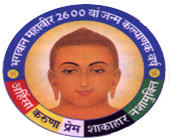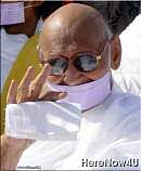
Ahimsa Times
Mahaveer: A Fearless Hero

 We live in a time when heroes are famous film stars, musicians or wealthy businessmen. Lord Mahaveer is still remembered and worshipped by millions today, 2600 years after his birth. Why? Acharya Mahaprajna examines the life story of Mahaveer and his message for the world.
We live in a time when heroes are famous film stars, musicians or wealthy businessmen. Lord Mahaveer is still remembered and worshipped by millions today, 2600 years after his birth. Why? Acharya Mahaprajna examines the life story of Mahaveer and his message for the world.
ON AN AUSPICIOUS DAY on 17th June, 599 B.C. (Ashad Shukla 6, Friday) LORD Mahaveer was born. The birth of a person in this world is a common event. A number of people are born unnoticed on this earth every day but Mahaveer's birth was marked by an uncanny element. While still growing in his mother's womb, Mahaveer was endowed with clairvoyance (avadhi gyan). An ordinary man is born with indirect knowledge (paroksh) but Mahaveer was born with direct knowledge (pratyaksh), as if he had experienced everything already. This was an extraordinary thing about his birth. When he grew up, he was sent to a local school but on the very first day his teacher noticed his transcendental wisdom and declared that he didn't require any schooling.
After Mahaveer's birth, his family began to grow prosperous. Impressed by this phenomenon, his parents gave him the name of Vardhman. Since he was clairvoyant, he came to be known as saman. Realizing his power of tolerance during spiritual practice, he was named as 'Mahaveer' by a class of gods. Two saints - Vijay and Sanjay - came. They saw Mahaveer and a mere glimpse of his personality dispelled all their doubts. A number of names were given and amid them lay hidden a nameless personality.
It is believed in modern times that man is free to think and act the way he likes, but this is a relative truth. He is not entirely free. He is also bound with liberation or salvation (moksha). There was a religious environment in his family and his parents were followers of the 23rd Jain Tirthankara, parshva. The teachings of Parshva left an indelible impression on his mind. Destiny, environment and the separation from the parents prompted Mahaveer to take to the ascetic way of life. When his elder brother, Nandivardhan came to know of his intention to embrace asceticism he asked him: "Brother, are you thinking of renouncing the household life?" "Yes", Mahaveer nodded his head in affirmation. Nandivardhan said: "Brother, is it the befitting occasion for such a decision? We have not yet recovered from the shock caused by the separation from our parents and you are thinking of renouncing the worldly relations. You must stay at home at least for two years, and thereafter you are free to have your own way." Mahaveer acceded to his elder brother's request.
From a very young age, Mahaveer was keen to leave the family and become a wandering monk, but he stayed for his parents' sake. A large number of people know that the past influences the present, but only a few know the truth that future too influences the present. Mahaveer's two-year stay at home was under the shadow of the future, so he lived like a monk. He realized that life is transient and was committed to renunciation. No one had ever imagined that a prince was living the life of a monk in a princely household.
On being permitted by his brother Nandivardhan, Mahaveer got initiated into an ascetic life. Having renounced the worldly relationships, he went off with the sole objective of achieving complete samayika (equanimous state of mind or state if super consciousness). His thirty-year long householder's life came to an end. He spent his childhood at home, entered his youth and enjoyed the regality of a princely life till he was twenty eight.
With his initiation into a new way of life, the vigorous practice of Samya Yoga (Yoga of equanimity) began and continued for twelve years. During this period he went through a number of ordeals which he successfully encountered. His name Mahaveer or great spiritual warrior proved true to its meaning. If a coward had come across these ordeals he would have hardly encountered even one of them. Equanimity (samta) and non-violence (ahimsa) require tremendous bravery.
We know Mahaveer as a pioneer of ahimsa. He is not yet widely known as a pioneer of fearlessness (abhaya). He had the firm belief that a person afflicted with fear cannot promote ahimsa. This principle became an integral part of his way of life. For this reason he remained alone during the whole span of his penance (spiritual practice). He wandered alone in the jungles, rivers, valleys, hills, caves and empty houses day and night. Fear did not touch him at all. Fearlessness added luster to his spiritual practice. Once, he stayed in the temple of Soolpani Yaksha. The priest warned him against the danger at night and asked him not to stay there, for no one survived till the dawn. Even the villagers dissuaded him but he remained firm and adamant. He did stay in the temple of the Yaksha despite warnings and advice to the contrary, and survived.
Lord Mahaveer was going to a hermitage when the cowherds said, "O, mendicant! Do not go further. There is a snake called Chand Kaushik at a little distance. the serpent can burn a man to ashes by casting a mere look at him." Ignoring the advice, Mahaveer continued his march. Fear of death and suffering was perhaps unknown to him. He approached the serpent's hole and stood there in a state of meditative posture. Chand Kaushik must have said to himself, "What kind of a man is this? He is coming to me to embrace death." His defiance infuriated him. The serpent first looked at the sun and then looked at Mahaveer. The waves of venom from the venomous looks spread far and wide but Mahaveer stood motionless in a meditative pose. Now, the serpent was beside itself with the fire of fierce rage. It coiled itself around Mahaveer's body and started stinging him at various points. He began to bleed but remained motionless like Mt. Meru. He countered the effect of the venom emitted from the serpent's eyes by means of radiations of compassion. Mahaveer had no enemy.
Lord Mahaveer's spiritual practice was the practice of renunciation. While embracing asceticism he had resolved: "I surrender this body for the sake of my soul. This body is not mine. With this feeling I shall use my body. To cross a river, a boat is needed. I shall use my body as a boat to cross the river of life. I shall bear all the pangs of suffering by being immersed in the soul." After becoming an ascetic he retained only a wrapping piece of cloth (uttariya). That piece of cloth fell off after it got entangled into a thorny bush. This is what one school of thought believes. The other possibility is that Mahaveer gave it up deliberately. It is very easy to say that in the practice of non-possession (aparigraha) Mahaveer stands in the first row of such dedicated practitioners.
Enlightened belief (samyag-darshan) became non-absolutism (anekanta) and the knowledge of the 'self' became enlightened knowledge (samyak gyan). Fearlessness, non-possession and non-violence (aparigraha, ahimsa, abhaya) became enlightened conduct (samyak charitra). This trio led Mahaveer to the attainment of omniscience (kevalya). At the sandy bank of the Baluke River, in the farm belonging to a householder named Shyamak, under a tree in Godohika posture, Mahaveer attained omniscience.
Acharya Mahaprajna is the spiritual leader of Terapanth, based in Ladnun, Rajasthan, India. He has written many books on Jain philosophy and psychology.
 Acharya Mahaprajna
Acharya Mahaprajna